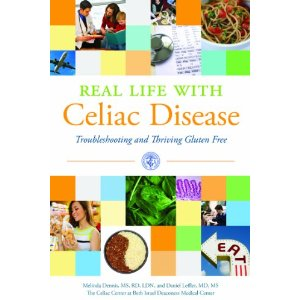 |
| Copyrighted illustration, AGA Press |
Are you among the millions with undiagnosed celiac disease or a gluten-related ailment? If you have unexplained depression, anemia, infertility, bone degeneration, liver disease, vitamin deficiency, or trouble with your balanceReal Life with Celiac Disease will help you consider whether you have undiagnosed celiac disease and need to go gluten-free.
I received this book to review from the American Gastroenterological Association (AGA). If I saw this on a shelf in a bookstore, it's likely I wouldn't have bought it. I've been dealing with celiac disease with fair success for a number of years now. I don't think I know it all, but after a while it all gets old. I have my cooking and dietary policies established and just want to move on with life. Nonetheless, I find I'm glad I received a review copy. I couldn't put it down.It you have been diagnosed with celiac disease or gluten sensitivity. Find out:Real Life with Celiac Disease, Troubleshooting and Thriving Gluten Free by Melinda Dennis, M.S., R.D., LDN and Daniel A. Leffler, M.D., M.S.
- Why you still have symptoms, even though you're eating gluten free
- Easy ways to adjust to a gluten-free lifestyle
- How to heal your gut with gluten-free fiber vitamins, minerals, probiotics, and more
- Where to look for hidden gluten and why cheating has serious consequences
- Whether you can eat oats and what starch and how to travel and dine out safely
- How to eat healthy if you are a vegetarian, have diabetes, or want to lose weight
- Which family members need to be tested for celiac disease
- How celiac disease should be monitored by your health care team throughout life
The book offers a chapter-by-chapter overview and update on all facets of celiac disease, each one written by a professional in that specific area. In textbook fashion, chapters end with suggested further reading. The book offers comprehensive, up-to-date, and practical information and guidance on a broad range of celiac disease and gluten-related disorders and issues.
The many values of Real Life with Celiac Disease include:
- up-to-date discussions of celiac conditions other than just the standard discussions of gastrointestinal issues, vitamin deficiency, and skin disease (dermatitis herpetiformis), including depression, liver disease, anemia, and osteoporosis
- clarification of the connections or lack there-of between celiac disease and various cancers, including breast cancer
- guidelines for successfully combining both vegetarian and diabetic diets with a gluten-free diet
- malabsorption of fructose, lactose, and related carbohydrates
- information on how your medical team should be monitoring your celiac disease
- guidance for reading food-labeling in Canada and the United States
- dealing with celiac disease when you have an eating disorder
- comprehensive information on successfully accommodating lifestyles
- information on infant feeding and celiac disease
Until the 1990s, we believed that celiac disease was unavoidable if the person had inherited the genetic risk from a parent. Then, between 1984 and 1996, Sweden experienced an epidemic of celiac disease in children under two years of age. Diagnosis of celiac disease rose to levels higher than found in any other country and then sharply declined back to the previous level. Clearly genetics isn't the only thing that determines the development of celiac disease; environment and lifestyle are important aspects, too.Real Life with Celiac Disease devotes a chapter to the changing diet of humans over the millenia, how celiac disease has evolved, why it is still often not recognized by physicians as anything more than a childhood disease, and why and how we have moved from incidence of celiac disease to prevalence.
One of the chapters I most appreciate is the chapter on combining a gluten-free diet with a vegetarian diet. Before I found I had celiac disease I was virtually vegan. My concessions to an animal-based diet were cream in my coffee and plain, nonfat Greek yogurt. I was discouraged from continuing that diet. Now I feel empowered to revisit that option and reevaluate.
I must say, I was ready to take a week or so to read the book in between doing other things, but that is not the case at all. Once started, I had to pursue it to the end. I found it to be clear, engaging, and recommend it as good choice for either an introduction to celiac disease or an update. It's comprehensive and organized in a way that will save you a lot of research time.
